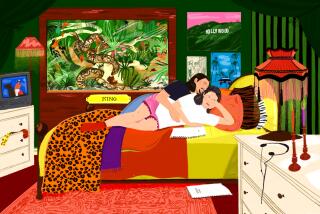Singleton Court in West Adams was the home of scandal
- Share via
It’s St. Valentine’s Day, and somewhere love is for sale, though not on sale. For centuries the wealthy have lured the sexy and beautiful with jewels, cigars, fine wines and racing cars. Kate Spade bags, David Yurman rubies, Rolex watches or a Swiss bank account can work. But to close the deal, there’s nothing like a well-furnished house.
France’s Louis XVI gave Marie Antoinette the Petit Trianon at Versailles. Blenheim Palace in England came with the duke of Marlborough when he married railroad heiress Consuelo Vanderbilt. Mary Pickford got Douglas Fairbanks and a Westside estate. For men and women, a thatched hut or an island retreat has been fair trade for good looks.
In 1900, John Singleton was a made-to-order husband -- 53, divorced, not bad-looking and rich from his Yellow Aster mine in Randsburg, in Kern County. He bought a fine, columned house at Flower Street and West Adams in L.A. designed by architect Carroll H. Brown in 1887. Its grounds were too modest for Singleton, so he landscaped the garden with specimen plants and built a carriage house and clock tower. He knighted his property Singleton Court, spelled out in iron letters above the long entrance drive.
Singleton hired William H. Hill of Pasadena to photograph his house, stable and garden. Black-and-white-photo albums were to the 19th century what Facebook is to the 21st. Transportable and reproducible, they were perfect for bragging to a prospective spouse. With sharply focused portraits of decorated interiors and landscaped grounds, Singleton created a leather-bound volume and stamped on its cover: Singleton Court. He inscribed the opening page: “A memento, to Stella, from Singleton.”
Stella Graham was just 20 when she received Singleton’s album. Its pages conjured up a world of Champagne taste that could be hers if only she’d marry the millionaire miner. Handwritten captions pointed to highlights in each photo. Singleton boasted of a “pair of rare old bronze Japanese vases,” a summer house, a blooming jacaranda, a carriage and a one-horse roadster. There was the Mexican helper, the liveried driver and the boss himself, suited up in front of the mansion. On his photograph Singleton wrote: “Flower St. Porch ‘Yours truly’ & dogs Rand & Trilby.”
Singleton’s ploy apparently worked. In 1901, he and Graham married in San Francisco and honeymooned in Hawaii before moving to Singleton Court. But as Mary Pickford and Marie Antoinette discovered, and as the duchess of Marlborough wrote about her own miserable marriage, “all that glitters is not gold.” In 1902, Singleton’s only son, Edward, feckless and drunk, shot himself to death at the family house. Four years later the mansion went up in flames, and so did the Singleton marriage. Columnists were merciless in their gossipy reports.
Graham, rumored to be Singleton’s maid before they married, had flung open the doors of Singleton Court to L.A. society. Whether “the gold from the Yellow Aster and the smiles from the maid” had done any good, no one was certain. The couple, after weeks of not speaking, agreed to separate for a year at a meeting with lawyers described by The Times as an opéra bouffe. A guaranteed income in hand, Graham left for Europe.
By 1911, she had returned to America and vouched for her sister Lillian Graham at a trial in New York. She was accused of shooting the notorious copper mine millionaire William E.D. Stokes after he’d made unwanted advances.
Singleton died at Yellow Aster in 1914, and Graham remarried twice after that. The house at Singleton Court was never rebuilt. In 1967, Orthopaedic Hospital razed the stable and tower to build an extension.
Watters is author of “Los Angeles Houses, 1885-1935.”
His columns are archived at latimes.com/lostla.
More to Read
Sign up for The Wild
We’ll help you find the best places to hike, bike and run, as well as the perfect silent spots for meditation and yoga.
You may occasionally receive promotional content from the Los Angeles Times.










